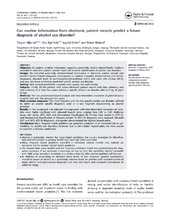Can routine information from electronic patient records predict a future diagnosis of alcohol use disorder?
Peer reviewed, Journal article
Published version

Åpne
Permanent lenke
https://hdl.handle.net/1956/15322Utgivelsesdato
2016Metadata
Vis full innførselSamlinger
Originalversjon
https://doi.org/10.1080/02813432.2016.1207138Sammendrag
Objective: To explore whether information regarding potentially alcohol-related health incidents recorded in electronic patient records might aid in earlier identification of alcohol use disorders. Design: We extracted potentially alcohol-related information in electronic patient records and tested if alcohol-related diagnoses, prescriptions of codeine, tramadol, ethylmorphine, and benzodiazepines; elevated levels of gamma-glutamyl-transferase (GGT), and mean cell volume (MCV); and new sick leave certificates predicted specific alcohol use disorder. Setting: Nine general practitioner surgeries with varying size and stability. Subjects: Totally 20,764 patients with active electronic patient record until data gathering and with a history of at least four years without a specific alcohol use disorder after turning 18 years of age. Methods: The Cox proportional hazard analysis with time-dependent covariates of potential accumulated risks over the previous four years. Main outcome measures: Time from inclusion until the first specific alcohol use disorder, defined by either an alcohol specific diagnostic code or a text fragment documenting an alcohol problem. Results: In the unadjusted and adjusted Cox-regression with time-dependent covariates all variables were highly significant with adjusted hazard ratios ranging from 1.25 to 3.50. Addictive drugs, sick leaves, GGT, MCV and International Classification for Primary Care version 2 (ICPC-2), and International Classification of Diseases version 10 (ICD-10) diagnoses were analyzed. Elevated GGT and MCV, ICD-10-diagnoses, and gender demonstrated the highest hazard ratios. Conclusions: Many frequent health problems are potential predictors of an increased risk or vulnerability for alcohol use disorders. However, due to the modest hazard ratios, we were unable to establish a clinically useful tool.
